Related Research Articles

Silicate minerals are rock-forming minerals made up of silicate groups. They are the largest and most important class of minerals and make up approximately 90 percent of Earth's crust.
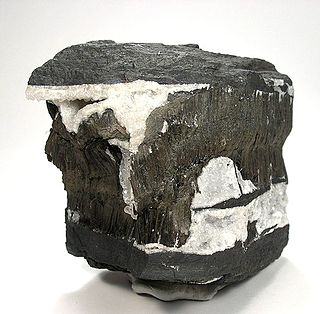
Todorokite is a complex hydrous manganese oxide mineral with generic chemical formula (Na,Ca,K,Ba,Sr)
1-x(Mn,Mg,Al)
6O
12·3-4H
2O. It was named in 1934 for the type locality, the Todoroki mine, Hokkaido, Japan. It belongs to the prismatic class 2/m of the monoclinic crystal system, but the angle β between the a and c axes is close to 90°, making it seem orthorhombic. It is a brown to black mineral which occurs in massive or tuberose forms. It is quite soft with a Mohs hardness of 1.5, and a specific gravity of 3.49 – 3.82. It is a component of deep ocean basin manganese nodules.
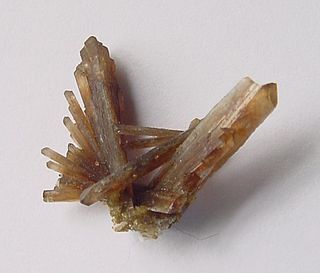
Childrenite is a rare hydrated phosphate mineral with elements iron, manganese, aluminium, phosphorus, oxygen and hydrogen. Its chemical formula is (Fe2+
,Mn)2+
AlPO
4(OH)
2•H
2O and it has a molecular weight of 229.83 g/mol. Its specific gravity is 3.2 and it has a Mohs hardness of 4.5 to 5. It is usually translucent and non-fluorescent, with imperfect cleavage. It has a vitreous lustre with a white streak, and is brown or yellow in color. It has a conchoidal, uneven fracture, and an orthorhombic crystal system.
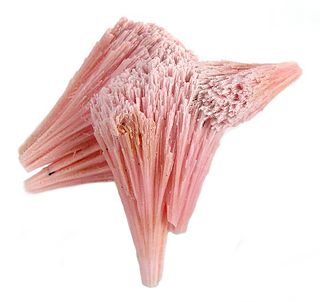
Kutnohorite is a rare calcium manganese carbonate mineral with magnesium and iron that is a member of the dolomite group. It forms a series with dolomite, and with ankerite. The end member formula is CaMn2+(CO3)2, but Mg2+ and Fe2+ commonly substitute for Mn2+, with the manganese content varying from 38% to 84%, so the formula Ca(Mn2+,Mg,Fe2+)(CO3)2 better represents the species. It was named by Professor Bukowsky in 1901 after the type locality of Kutná Hora, Bohemia, in the Czech Republic. It was originally spelt "kutnahorite" but "kutnohorite" is the current IMA-approved spelling.
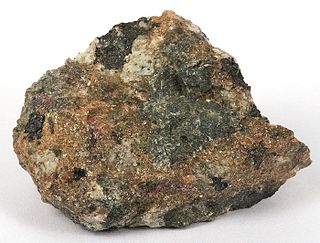
Nelenite is a rare manganese iron phyllosilicate arsenate mineral found in Franklin Furnace, New Jersey.
Jarosewichite is a rare manganese arsenate mineral with formula: Mn2+3Mn3+(AsO4)(OH)6. It was first described in Franklin, New Jersey which is its only reported occurrence. Its chemical composition and structure are similar to chlorophoenicite. This mineral is orthorhombic with 2/m2/m2/m point group. Its crystals are prismatic or barrel-shaped. The color of jarosewichite is dark red to black. It has subvitreous luster of fracture surfaces and reddish-orange streak. This mineral occurs with flinkite, franklinite, andradite and cahnite.
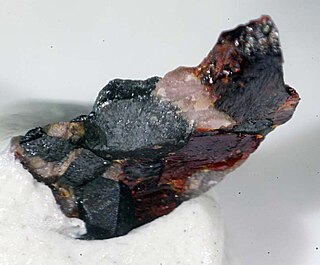
Jerrygibbsite is a rare silicate mineral with the chemical formula (Mn,Zn)9(SiO4)4(OH)2. Jerrygibbsite was originally discovered by Pete J. Dunn in 1984, who named it after mineralogist Gerald V. Gibbs. It has only been reported from the type locality of Franklin Furnace, New Jersey, United States, and in Namibia's Otjozondjupa region. Jerrygibbsite is member of the leucophoenite family of the humite group. It is always found with these two minerals. It is a dimorph of sonolite.
Zussmanite is a hydrated iron-rich silicate mineral with the chemical formula K(Fe2+,Mg,Mn)13[AlSi17O42](OH)14. It occurs as pale green crystals with perfect cleavage.

Stilpnomelane is a phyllosilicate mineral. It has the chemical formula K(Fe2+,Mg,Fe3+)8(Si,Al)12(O,OH)27·n(H2O).

Cyrilovite (NaFe33+(PO4)2(OH)4·2(H2O)) is a hydrous sodium iron phosphate mineral. It is isomorphous and isostructural with wardite, the sodium aluminium counterpart.
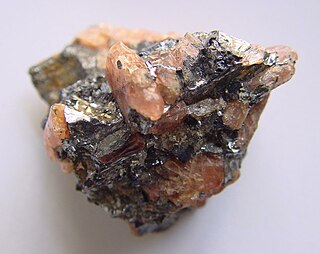
Bustamite is a calcium manganese inosilicate (chain silicate) and a member of the wollastonite group. Magnesium, zinc and iron are common impurities substituting for manganese. Bustamite is the high-temperature polymorph of CaMnSi2O6 and johannsenite is the low temperature polymorph. The inversion takes place at 830 °C (1,530 °F), but may be very slow.
Bustamite could be confused with light-colored rhodonite or pyroxmangite, but both these minerals are biaxial (+) whereas bustamite is biaxial (−).

Zemannite is a very rare oxide mineral with the chemical formula Mg0.5ZnFe3+[TeO3]3·4.5H2O. It crystallizes in the hexagonal crystal system and forms small prismatic brown crystals. Because of the rarity and small crystal size, zemannite has no applications and serves as a collector's item.

Pimelite was discredited as a mineral species by the International Mineralogical Association (IMA) in 2006, in an article which suggests that "pimelite" specimens are probably willemseite, or kerolite. This was a mass discreditation, and not based on any re-examination of the type material. Nevertheless, a considerable number of papers have been written, verifying that pimelite is a nickel-dominant smectite. It is always possible to redefine a mineral wrongly discredited.

Jimthompsonite is a magnesium iron silicate mineral with chemical formula (Mg,Fe2+)5Si6O16(OH)2. It is a triple chain silicate (or inosilicate) along with clinojimthompsonite and chesterite. They were described in 1977 by Burham and Veblen. They attracted great mineralogical attention because they were the first examples of new chain silicate structures among a large group known as biopyriboles whose name is derived from the words biotite, pyroxene, and amphiboles.

Leucophoenicite is a mineral with formula Mn7(SiO4)3(OH)2. Generally brown to red or pink in color, the mineral gets its name from the Greek words meaning "pale purple-red". Leucophoenicite was discovered in New Jersey, US and identified as a new mineral in 1899.

Brokenhillite is a rare mineral that is only found in the far-western regions of New South Wales in Broken Hill, Australia. Although it has been given a name and chemical formula, it has not been approved by the International Mineralogical Association primarily because it is a manganese silicate of the pyrosmalite group which means the compositional similarities are too great to be an approved mineral. Brokenhillite structure is either composed of iron or manganese with the formula (Mn+2,Fe+2)8Si6O15(OH,Cl)10. The actual components inside brokenhillite can be determined using a diffractometer. The structural basis of this mineral is determined to be phyllosilicate within the pyrosmalites due to the octahedral structure, with one perfect cleavage, a hardness of about 4.5, and a streak of light brown.
Chvaleticeite is a monoclinic hexahydrite manganese magnesium sulfate mineral with formula: (Mn2+, Mg)[SO4]·6(H2O). It occurs in the oxidized zone of manganese silicate deposits with pyrite and rhodochrosite that have undergone regional and contact metamorphism. It is defined as the manganese dominant member of the hexahydrite group.
Filipstadite is a very rare mineral of the spinel group, with the formula (Mn,Mg)(Sb5+0.5Fe3+0.5)O4. It is isometric, although it was previously though to be orthorhombic. When compared to a typical spinel, both the octahedral and tetrahedral sites are split due to cation ordering. Filipstadite is chemically close to melanostibite. The mineral comes from Långban, Sweden, a manganese skarn deposit famous for many rare minerals.

Serrabrancaite is a mineral with the chemical formula MnPO4•H2O and which is named for the locality where it was found, the Alto Serra Branca Pegmatite. The Alto Serra Branca mine has been in operation since the 1940s. It is located in Paraiba, Brazil near a village named Pedra Lavrada. Tantalite is the main mineral mined here. Specimens of serrabrancaite are kept in the Mineralogical Collections of both the Bergakademie Freiberg, Germany and the Martin-Luther Universität Halle, Institut für Geologische Wissenschaften.

Antigorite is a lamellated, monoclinic mineral in the phyllosilicate serpentine subgroup with the ideal chemical formula of (Mg,Fe2+)3Si2O5(OH)4. It is the high-pressure polymorph of serpentine and is commonly found in metamorphosed serpentinites. Antigorite, and its serpentine polymorphs, play an important role in subduction zone dynamics due to their relative weakness and high weight percent of water (up to 13 weight % H2O). It is named after its type locality, the Geisspfad serpentinite, Valle Antigorio in the border region of Italy/Switzerland and is commonly used as a gemstone in jewelry and carvings.
References
- ↑ Warr, L.N. (2021). "IMA–CNMNC approved mineral symbols". Mineralogical Magazine. 85 (3): 291–320. Bibcode:2021MinM...85..291W. doi: 10.1180/mgm.2021.43 . S2CID 235729616.
- 1 2 3 Anthony, J. W., BideauxR, A., Bladh, K. W., and Nichols, M. C., 2001, Franklinphilite, Handbook of Mineralogy, Mineralogical Society of America.
- 1 2 Franklinphilite on Mindat.org
- 1 2 Franklinphilite data on Webmineral
- ↑ "Tanatz Alp, Splügen, Rheinwald, Viamala Region, Grisons, Switzerland".
- ↑ "Mineral Database".
- 1 2 3 4 5 6 Dunn, P.J., Peacor, D.R., and Su S.-C., 1992, Franklinphilite, the manganese analog of stilpnomelane, from Franklin, New Jersey. Mineral Record v. 23 p. 465-468.
- ↑ Dunn, P. J., Peacor, R. D., and Simmons, W. B., 1984, Lennilenapeite, The Mg-Analogue Of Stilpnomelane, And Chemical Data On Other Stilpnomelane Species From Franklin, New Jersey, Canadian Mineralogist v. 22 p. 259-63.
- ↑ Dana, J. D., Dana, E.S., Gaines, R.V., and Dana, J.D., 1997, Dana’s New Mineralogy: The System of Mineralogy of James Dwight Dana and Edward Salisbury Dana. 8th ed., p. 1553-1554